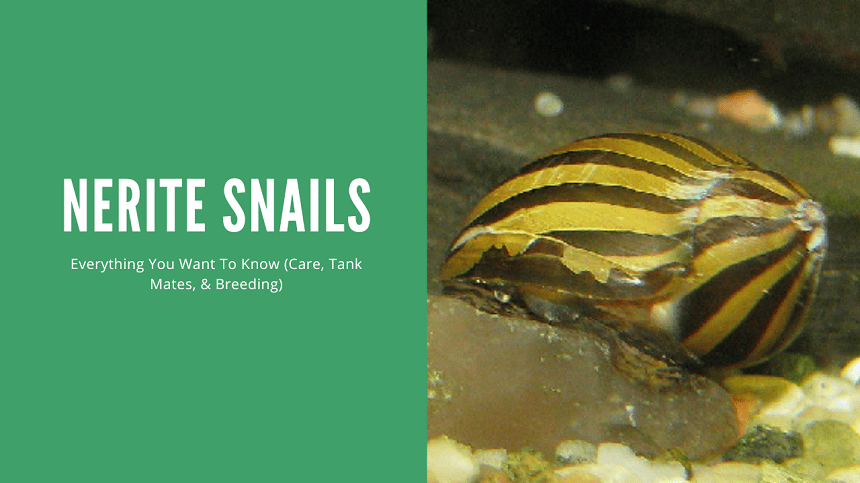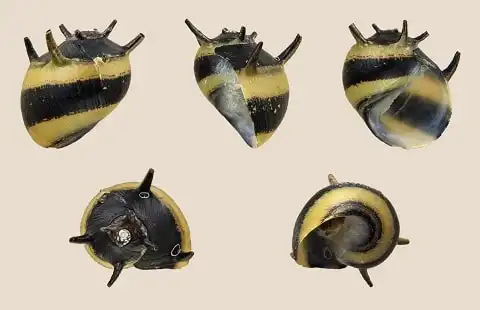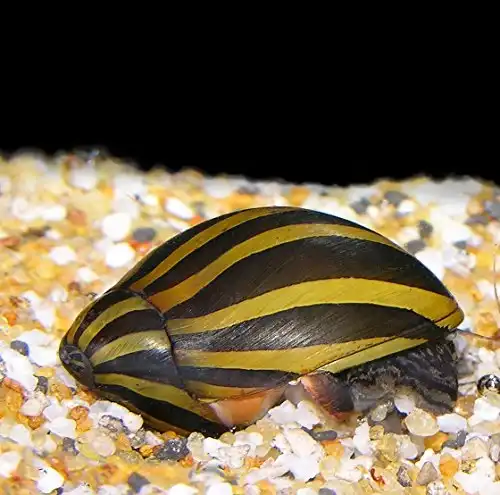Thank you for visiting! By the way… any links on this page that lead to products on Amazon and other stores/partners are affiliate links Aquarium Store Depot earns a commission if you make a purchase.
If you are looking for a reliable algae eater, Nerite Snails are one of the best choices for an aquarium. They are easy to care for, don’t breed in freshwater aquariums, and won’t tear up your live plants. Today, we will discuss their origins, go over types, their diet, and how to keep them happy and healthy. So if you’re thinking about adding some nerite snails to your tank, read on! You won’t regret it!
Key Takeaways
- Nerite snails are excellent algae eaters
- They will not overpopulate a tank as they require brackish water to successfully breed
- They come in a variety of types and are generally hardy for a snail
- They will not harm your plants
Species Overview
| Scientific Name | Neritina spp |
| Common Names | Nerite snails, nerites |
| Family | Neritidae |
| Origin | Coastal regions of the Atlantic, Indian, and Pacific Oceans |
| Diet | Herbivore |
| Care Level | Easy |
| Activity | Low |
| Lifespan | 1-10 years |
| Temperament | Peaceful |
| Tank Level | All |
| Minimum Tank Size | 5 gallons |
| Temperature Range | 65-85° F |
| Water Hardness | 10-25 KH |
| pH Range | 6 to 8 |
| Filtration/Water Flow | Slow to moderate |
| Water Type | Freshwater |
| Breeding | Egg layer |
| Difficulty to Breed | Difficult |
| Compatibility | Community tanks |
| OK, for Planted Tanks? | Yes |
Introduction
Nerite snails are an anomaly in the aquarium hobby. They are one of the few species that can be kept in entirely freshwater or saltwater conditions as well as mixed salinities in between. Nerites are also one of the best algae-eating species of snail available, making them one of the most popular–and one of the more expensive–types of aquarium snail.
This article will focus only on freshwater nerite snails and their care requirements.
How Long Do They Live?
In general, nerite snails will live for at least one year in the freshwater aquarium. Under ideal conditions, they have been known to live for a decade. How long nerite snails live varies a lot. And hobbyists aren’t necessarily paying attention to how long their snails live.
Nerite snails are generally hardy, but they can be sensitive to ammonia and nitrite in the water column, which means that they need a more established setup.
Are They Good For Your Freshwater Tank?
A nerite snail is one of the best additions you can make to your freshwater aquarium, especially a planted aquarium! These snails have a serious appetite for algae.
Nerite snails are proficient algae eaters. They will eat most species of algae, but are most efficient at cleaning up soft types, like hair algae, green spot algae, and green slime algae. They use their modified tongue, called a radula, covered in tiny teeth that help scrape away microflora.
As we’ll see, nerite snails are largely herbivores. They won’t necessarily clean detritus from fish and other organisms in the tank, but they’ll keep plant surfaces and the sides of the aquarium algae-free.
How To Identify
Snails can be hard to tell apart. And the problem is that not all snails are created equally.

Some snails clean algae better while others take care of detritus and even other snails. Freshwater snails can also be expensive, so you definitely want to take the time to understand what the species of snail you want looks like.
Nerite snails are a larger species of snail. There are many species of aquarium snail that belong to the Neritina genus, each with its own identifying characteristics.
No matter the species though, nerite snails grow to be about 1-2 inches on average. These snails have an unbalanced appearance to them, with a rounded shell that tilts into a whorl on the right side. The body of the snail ranges in color from tan to dark brown. Unlike other snails, the body of the snail is usually concealed completely under the shell even when moving.
Unfortunately, there is no way to tell a male nerite snail apart from a female. Another big difference from other snails is that nerite snails are not hermaphrodites. This, in addition to their need for brackish water conditions, makes breeding nerite snails very difficult for the average hobbyist.
Origin and Habitat
Nerite snails have a wide distribution. Most species originate from the coastal waters of Africa but a few are found in the Caribbean or on the margins of the Pacific Ocean. Nerite snails are intertidal and regularly move between the nearby ocean and freshwater rivers and inlets; it is believed that they prefer brackish water conditions most of all.
This crossover between ecosystems leaves nerite snails with a large assortment of foods to eat. They will regularly be seen munching away at algae on rocks and other structures but will travel across the open sandbed as they grow and reproduce.
Care
In the aquarium, nerite snails are relatively hardy. They aren’t as hardy as something like the bladder snail (Physella acuta) that can survive polluted waters, but nerites can definitely withstand some beginner’s mistakes. Nerite snails are most sensitive to changes in ammonia and nitrite.
Otherwise, nerite snails are easy to care for in the freshwater aquarium. If there are enough algae to graze on, they will live for a relatively long time.
Tank Size
Freshwater snails are often limited in tank size due to their high reproductive rates. Nerite snails do not breed in freshwater, so they are one of the better choices for smaller aquariums.
The general rule for nerite snails is 1 snail for every 5 gallons of water; this means that 1 snail will comfortably fit in a 5-gallon betta tank or other planted aquarium. For larger tanks, the number of nerite snails will be limited by bioload. As these snails don’t reproduce in freshwater, there is no way to unknowingly overstock them as long as there is adequate biological filtration.
Aquarium Setup
Nerite snails can be kept in most freshwater tank setups. They excel in planted aquariums with lots of natural algae and microflora that they can graze on, but they’re also suitable for unplanted tanks as long as their dietary needs are met.
Nerite snails aren’t shy, but they’re mostly nocturnal. In fact, nerite snails can sleep for days at a time, only becoming active in short spurts. This means that they prefer to stay somewhere hidden to stay out of reach of predators. Driftwood, plants, rocks, and other aquarium structures can make perfect nooks and crannies for your snail to rest.
Because they’re nocturnal, nerite snails will also prefer dim lighting. The aquarium light may be dimmed or floating live plants and other large plant species may be used to create pockets of shade and refuge throughout the aquarium.
Nerite snails are also intertidal, which means that they regularly move between the water and moist, but not submersed, surfaces. It is not unusual to find a nerite snail at or above the waterline of the tank. They often find their way into the filter and might even crawl onto the outside of the glass. Because of this, it’s strongly recommended to use a fitted aquarium cover.
Water Parameters
Nerite snails need 0 ppm ammonia and 0 ppm nitrite. Any traces of ammonia or nitrite could prove to be deadly to your snails. Like other invertebrates, they also cannot tolerate copper.
Otherwise, these freshwater snails do not need specific water parameters. They are largely tropical species that need a warm water temperature. With proper acclimation, they can be kept at slightly cooler or warmer temperatures. Freshwater nerite snails also prefer a near-neutral water pH between 6.5-8.0 but can adapt to more acidic conditions.
Preferred water parameters largely depend on the conditions the snails are originally being kept. Remember, these are brackish water snails that can tolerate higher salinities and subsequent higher pH levels. Brackish water salinity measures at about 1.005 to 1.010 while full saltwater is 1.023 to 1.025.
Like other snails, nerite snails grow with their shells. They use calcium and other minerals available in the water column to continue growing and maintaining their shells. While these minerals are usually readily available with good source water, they may need to be supplemented every now and then through their diet or with calcium blocks.
An injured or nutrient-deficient nerite snail may have noticeable white scrapes and scratches across its shell. These injuries will continue to progress if calcium isn’t made available for repairs.
Filtration and Aeration
Even though nerite snails only grow to be about an inch or two, they can still create a significant amount of bioload that can affect the efficiency of the filtration being used. That being said, they have also been successfully kept in Walstad-method aquariums that rely solely on the biological filtration provided by live plants and bacteria without any additional equipment.
If the overall bioload of the aquarium is on the higher side, then it could be beneficial to add aeration for better oxygenation and gas exchange.
Lighting
Remember, nerite snails are nocturnal and have an interesting sleep cycle. Lighting intensity doesn’t matter too much, but these snails definitely need a discernible night and day cycle to keep a semi-regular sleep cycle.
Aquatic Plants and Decorations
Nerite snails absolutely love aquatic plants and decorations! But they’re not entirely necessary for the success of the snail.
Nerite snails eat algae that grow on the surfaces of the tank. That means the more surfaces available, the more food your snail has to choose from. They are unlikely to eat healthy live aquarium plants but will help consume any rotting stems or leaves.
Community Tank Mates
As a larger type of snail, nerite snails are among the best community tank snail species. These snails tend to keep to themselves and won’t disrupt other peaceful species.
This makes nerite snails completely compatible with:
In most cases, betta fish can be kept with nerite snails. The problem is that nerite snails can fall off the glass, occasionally landing on their back with their body exposed (yes! these snails can flip themselves back over). A curious or hungry betta may pick at the snail while it’s vulnerable, like other larger and more aggressive fish species.
How Many Should Be Kept Together?
As mentioned before, 1 nerite snail should be kept per every 5 gallons of water. However, you do not need to worry about your snails rapidly reproducing and overpopulating the tank, which leads to less likelihood of adding too many snails. Still, these are larger snails that can produce significant waste in bigger groups and should not be overstocked.
Food and Diet
Nerite snails will feed themselves as long as there is enough algae available in the tank.
There is little need to offer your snails anything additional to eat, though some hobbyists like to feed algae wafers and blanched vegetables, like cucumbers and lettuce; providing fresh vegetables from time to time can help introduce minerals and nutrients that can’t be obtained otherwise.
In the same way, calcium blocks may be added for healthy shells.
Breeding
Breeding nerite snails are extremely difficult for the average hobbyist. This is because it takes several fish tank setups to be successful. In the wild, nerite snails move between freshwater and saltwater. They are most often observed in brackish conditions for reproductive purposes.
Hobbyists seem to have the most breeding success when acclimating or keeping nerite snails in brackish water. When ready, a male and female will breed. The female will lay eggs in a safe area, usually on the aquarium glass or under a leaf. The nerite snail eggs will hatch after some time into larvae that later develop into recognizable, baby snails.
Nerite snails will not breed in the freshwater aquarium. Female nerite snails may lay their eggs around the aquarium, but they will not hatch. Take this as an indication that your snail is happy and healthy.
Do They Reproduce Asexually?
Many freshwater snails reproduce asexually. Nerite snails are fully sexual, though. This means that both a male and a female are needed to reproduce. This can make breeding these snails even more difficult as there are no observable physical differences between the two sexes. Hobbyists need to use large groups of snails to increase the chances of a male and female meeting and breeding.
4 Types
There are many species of nerite snail, though only a few have made their way into the aquarium hobby. Luckily, there aren’t any big differences between the different types of nerite snails, so you can trust that your aquarium will always get cleaned!
This includes zebra horned nerite snails, zebra nerite snails, tiger nerite snails, and black racer nerite snails.
1. Horned
Horned Nerite Snails are excellent algae eaters for planted tanks.
- Adult Size: 0.5 inches
- Color Pattern: Black and yellow spiral
- Unique Traits: Small spikes that outline the whorl
The zebra horned nerite snail (Clithon corona/diadema), also known as the zebra thorned nerite snail, is one of the most interesting-looking snails out of all freshwater snail species!
These are tiny snails, usually staying under an inch at full size. Zebra horned nerite snails have beautiful alternating black and yellow stripes, which can help bring a pop of color to the bottom of the fish tank. Their most interesting feature is the tiny spikes that outline the whorl of the shell. These are most likely used in defense against aggressive fish and invertebrates.
2. Zebra
Nerite snails are one of the best algae eating snails you can buy. Plant safe and do not reproduce in fresh water!
- Adult Size: 1 to 1.5 inches
- Color Pattern: Yellow and black/brown
- Unique Traits: Alternating black and yellow zebra pattern
The zebra nerite snail (Vittina natalensis) is probably the most recognizable species of nerite in the aquarium hobby. These snails are large with very smooth shells. Zebra nerite snails are mostly known for the unique pattern on their shells.
The color of the zebra nerite shell can vary from light yellow to warm orange. Every snail will have a zebra-like pattern with alternating black and yellow stripes that meet at the center of the whorl. Though inexpensive, these snails can bring a clean and expensive aesthetic to freshwater tanks.
3. Tiger
These Nerite Snails will eat algae, are plant safe, and do not reproduce in your aquarium!
- Adult Size: 1 to 1.5 inches
- Color Pattern: Yellow or orange with black patterning
- Unique Traits: Simple, uniform black spot patterning
Often sold alongside related zebra nerite snails, the tiger nerite snail (Neritina semiconca) has a beautiful natural appearance. These snails can vary in color intensity, from light yellows to dark browns. They are most easily identifiable by the flake-shaped black specks that run across the front of the shell and onto the whorl.
4. Black Racer
- Adult Size: 1 to 1.5 inches
- Color Pattern: Black Appearance
- Unique Traits: Dark ebony base color with lighter striations
Not the most popular, the black racer nerite snail (often categorized as Neritina pulligera) is actually one of the most common nerite snail species to come across at local fish stores. These snails are plain in color under poor lighting and appear as dark brown or black shells. However, under the right light, this species of nerite snail can become a spectacle with dark greens and browns with lighter colors (video source).
Compared to the other nerite snail species on this list, the black racer nerite snail tends to grow to a larger adult size.
Final Thoughts
There are many types of nerite snails to choose from. Each one has its own colorful appeal, but they are all excellent algae eaters that will help keep freshwater tanks clean without disrupting any other the tank inhabitants.
One of the best aspects of the nerite snail is that they can’t reproduce in pure freshwater. However, they can still carry a high bio load so it’s important to not overstock a tank.
- About the Author
- Latest Posts
I’m thrilled that you found Aquarium Store Depot! Here you’ll find information on fish, aquariums, and all things aquatics related. I’m a hobbyist (being doing this since I was 11) and here to help other hobbyists thrive with their aquariums! I adhere to a high quality Editorial Process and Review products with real life field usage and practical analysis.









Thank you! I have an older black/brown plain nerite. it is 2 years old. recently, it has been falling over. When I pick it up and hold it, it starts moving. I made a floating spatula ramp and attached it with hair clips. now it has the option or water for air. I had to get creative. I just wanted to share.
Again, thank you for the great information.
R